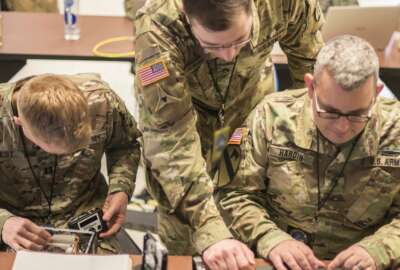

U.S. Cyber Command put its prototype training environment to the test.
Part of U.S. Cyber Command’s billion dollar training contract was ready at the right time this year as more than 500 personnel worldwide came together virtually during the coronavirus pandemic to stop simulated cyber attacks.
Cyber Flag — a mass cyber training exercise that brings together different military services, countries and government agencies — was able to continue this year in part because of the Persistent Cyber Training Environment (PCTE).
PCTE allowed Cyber Flag to move forward even as COVID-19 kept the 17 teams participating in the event from working in the same physical location.
“In Cyber Flag 18 and Cyber Flag 19 conducted in the previous years, we would bring about 800 cyber mission force warfighters, allies and interagency partners together at the Joint Staff facility in Virginia to conduct training in a range that was geographically located in that area,” Rear Admiral John W. Mauger, CYBERCOM director of exercises, told reporters Wednesday.
“As we went into the COVID-19 environment, we realized that the opportunity to bring that many people together into a single facility was not possible,” he said. “It was not possible because of travel and it was not possible because of the need to stay physically distant from one another. We had to come up with a way of achieving the same outcome, bringing all those warfighters allies, partners, interagency members together into a similar environments to allow them to interact, hone their skills and really collaborate.”
Coronavirus lit a fire underneath CYBERCOM to prepare its new PCTE to conduct the exercise.
“We were able to accelerate the design and delivery of the exercise and a completely distributed environment, which is very, very different from years past,” Mauger said. “Rather than having all those members sitting in one building, we’re operating this exercise over nine different time zones in five different geographic locations with five different countries around the world.”
Some people were even able to participate in their homes.
The PCTE itself is an online system that the force can log onto in order to conduct the training.
Some examples of what cyber mission forces will be able to simulate include taking down terrorists’ online tools to disrupt recruiting and propaganda. Advanced malware could also be placed in the environment, where teams can find and mitigate its risk.
As for Cyber Flag itself, the cyber operators were tasked with protecting a fictional air base from cyber attacks. They had to protect personnel identifying information and industrial control systems that regulate the base’s power grid, air traffic control and other infrastructure.
What’s next for the PCTE is taking it out of the prototype phase with the Cyber Training, Readiness, Integration, Delivery and Enterprise Technology or Cyber TRIDENT.
Cyber TRIDENT is the larger billion-dollar contract that encompasses PCTE and other services for cyber training.
It picks up the heavy lifting for lifecycle integration of PCTE into the military services and increasing its capabilities.
The Army released its request for proposals for TRIDENT on June 11. The request describes the needs of the contract as:
The Army plans on awarding that contract in about a year.
Copyright © 2025 Federal News Network. All rights reserved. This website is not intended for users located within the European Economic Area.
Scott Maucione is a defense reporter for Federal News Network and reports on human capital, workforce and the Defense Department at-large.
Follow @smaucioneWFED

